This document summarizes an algorithm for implementing a double precision floating point adder according to the IEEE 754 standard. The algorithm uses several optimization techniques to reduce latency, including separating the computation into two parallel paths based on the operands and operation, reducing the number of IEEE rounding modes, using a sign-magnitude representation for subtraction, and performing prefix addition of the significands. Analysis using the logical effort model estimates the delay of this optimized design is 30.6 FO4 delays, an improvement over prior designs.
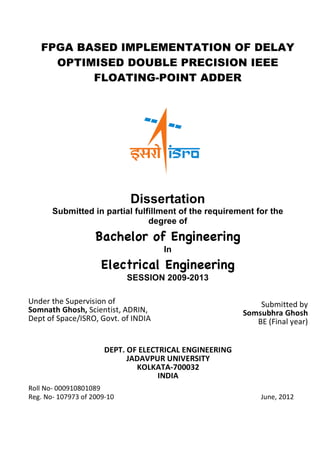



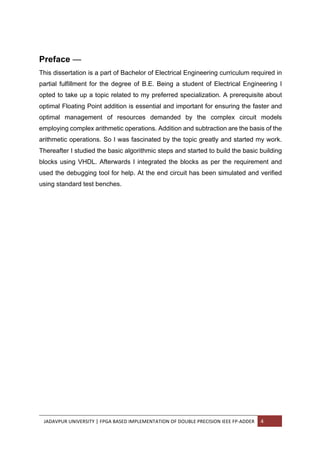


![JADAVPUR UNIVERSITY | FPGA BASED IMPLEMENTATION OF DOUBLE PRECISION IEEE FP-ADDER 7
SECTION I. INTRODUCTION AND SUMMERY
FLOATING-POINT addition and subtraction are the most frequent floating-point
operations. Both operations use a floating-point adder (FP-adder). Therefore, a lot of
effort has been spent on reducing the latency of FP-adders (see [2], [9], [20], [22], [23],
[25], [27], [28], and the references that appear there). Many patents deal with FP-
adder design (ref. [6], [10], [11], [14], [15], [19], [21], [31], [32], [35]). In this dissertation
an FP-adder design is implemented that accepts normalized double precision
significands, supports IEEE rounding modes, and outputs the normalized
sum/difference that is rounded according to the IEEE FP standard 754 [13]. The
latency of this design is analyzed using the Logical Effort Model [33]. This model allows
for technology-independent delay analysis of CMOS circuits. The model enables
rigorous delay analysis that takes into account fanouts, drivers, and gate-sizing.
Following Horowitz [12], the delay of an inverter is used, the fanout of which equals 4,
as a technology-independent unit of delay. An inverter with fanout 4 is denoted by
FO4. The analysis using the Logical Effort Model shows that the delay of this FP-adder
design is 30:6 FO4 delays. This design is partitioned into two pipeline stages, the delay
of which is bounded by 15:3 FO4 delays. Extensions of the algorithm that deal with
denormal inputs and outputs are discussed in [16], [27]. It is shown there that the delay
overhead for supporting denormal numbers can be reduced to 1-2 logic levels (i.e.,
XOR delays). Several optimization techniques are employed in this algorithm. A
detailed examination of these techniques combined, enables implementation of an
overall fast FP-adder design. In particular, effective reduction of latency by parallel
paths requires balancing the delay of the paths. Such a balance is achieved by a gate-
level consideration of the design.
The optimization techniques, that has been used are included in the following -
1. A two path design with a nonstandard separation criterion. Instead of separation based
on the magnitude of the exponent difference [10], A separation criterion is defined that
also considers whether the operation is effective subtraction and the value of the
significand difference. This separation criterion maintains the advantages of the
standard two-path designs, namely, alignment shift and normalization shift take place
only in one of the paths and the full exponent difference is computed only in one path.
In addition, this separation technique requires rounding to take place only in one path.](https://image.slidesharecdn.com/d660715b-140b-4198-b373-7f155384b941-160513193802/85/FPGA-BASED-IMPLEMENTATION-OF-DELAY-OPTIMISED-DOUBLE-PRECISION-IEEE-FLOATING-POINT-ADDER-8-320.jpg)
![JADAVPUR UNIVERSITY | FPGA BASED IMPLEMENTATION OF DOUBLE PRECISION IEEE FP-ADDER 8
2. Reduction of IEEE rounding to three modes [25] and use of injection based rounding
[8].
3. A simpler design is obtained by using unconditional preshifts for effective subtractions
to reduce to 2 the number of binades that the significands’ sum and difference may
belong to.
4. The sign-magnitude representation of the difference of the exponents and the
significands is derived from one’s complement representation of the difference.
5. A parallel-prefix adder is used to compute the sum and the incremented sum of the
significands [34].
6. Recordings are used to estimate the number of leading zeros in the nonredundant
representation of a number represented as a borrow-save number [20].
7. Postnormalization is advanced and takes place before the rounding decision is ready.
Form an overview of FP-adder algorithms from technical papers and patents, the
optimization techniques that are used in each of these designs are summarized. The
algorithms from two particular implementations are also analyzed from literature in
some more detail [11], [21]. To allow for a “fair” comparison, the functionality of these
designs are adopted to match the functionality of the present design. This design uses
simpler rounding circuitry and is more amenable to partitioning into two pipeline stages
of equal latency. The latency of [21] is also analyzed using the Logical Effort Model.
The analysis for this algorithm gives the following results:
a) The total delay is 35:2 FO4 delays (i.e., 13 percent slower than this design) and the
delay of the slowest pipeline stage is 19:7 FO4 delays (i.e., 22 percent slower).
b) This paper focuses on double precision FP-adder implementations. Many FP-adders
support multiple precisions (e.g., x86 architectures support single, double, and
extended double precision). In [27], it is shown that by aligning the rounding position
(i.e., 23 positions to the right of the binary point in single precision and 52 positions to
the right of the binary point in double precision) of the significands before they are
input to the design and post aligning the outcome of the FP-adder, it is possible to use
the FP-adder presented in the mentioned paper for multiple precisions. Hence, the
FP-addition algorithm presented in this paper can be used to support multiple
precisions.
SECTION II. NOTATION
Values and their representation:](https://image.slidesharecdn.com/d660715b-140b-4198-b373-7f155384b941-160513193802/85/FPGA-BASED-IMPLEMENTATION-OF-DELAY-OPTIMISED-DOUBLE-PRECISION-IEEE-FLOATING-POINT-ADDER-9-320.jpg)
![JADAVPUR UNIVERSITY | FPGA BASED IMPLEMENTATION OF DOUBLE PRECISION IEEE FP-ADDER 9
Binary strings are denoted by upper case letters (e.g., S, E, F). The value represented
by a binary string is represented in italics (e.g., s; e; f) IEEE FP-numbers. Here
normalized IEEE FPnumbers are considered. In double precision, IEEE FP-numbers
are represented by three fields (S, E [10:0], F [0:52]) with sign bit S {0 : 1}, exponent
string E[10:0] ∈ {0,1}11
and significand string F[0:52] ∈ {0,1}53
. The values of exponent
and significand are defined by:
𝑒 = 𝐸[𝑖] ∙ 2+,-
+.- − 1023, 𝑓 = 𝐹[𝑖] ∙ 25+,-
+.- .
Since only normalized FPnumbers are considered, it can be safely concluded that f ∈
[1,2). The value represented by a FP-number (S, E[10:0], F[0:52]) is:
𝑓𝑝9:; 𝑆, 𝐸, 𝐹 = (−1)>
∙ 2?
∙ 𝑓.
Factorings: Given an IEEE FP-number (S,E,F) it is referred to the triple (s,e,f) as the
factoring of the FP-number. Note that s = S since S is a single bit. The advantage of
using factorings is the ability to ignore representation details and focus on values.
Inputs: The inputs of a FP-addition/subtraction are:
Operands denoted by (SA,EA[10:0],FA[0:52]) and (SB,EB[10:0],FB[0:52] ).
Operation denoted by SOP ∈ {0,1} to indicate addition/subtraction.
IEEE rounding mode.
Output: The output is a FP-number (S,E[10:0],F[0:52] ). The value represented by the
output equals the IEEE rounded value of
𝑓𝑝𝑠𝑢𝑚 = 𝑓𝑝9:; 𝑆𝐴, 𝐸𝐴 10: 0 , 𝐹𝐴 0: 52 + (−1)>JK
∙ 𝑓𝑝9:; 𝑆𝐵, 𝐸𝐵 10: 0 , 𝐹𝐵 0: 52 .](https://image.slidesharecdn.com/d660715b-140b-4198-b373-7f155384b941-160513193802/85/FPGA-BASED-IMPLEMENTATION-OF-DELAY-OPTIMISED-DOUBLE-PRECISION-IEEE-FLOATING-POINT-ADDER-10-320.jpg)
![JADAVPUR UNIVERSITY | FPGA BASED IMPLEMENTATION OF DOUBLE PRECISION IEEE FP-ADDER 10
SECTION III. NAIVE FP-ADDER ALGORITHM
In this section, the “vanilla” FP-addition algorithm has been discussed. To simplify
notation, representation has been neglected and only the values of the inputs, outputs,
and intermediate results are taken into account. Throughout the paper, the notation
defined for the naive algorithm has been used. Let 𝑠𝑎, 𝑒𝑎, 𝑓𝑎 𝑎𝑛𝑑 (𝑠𝑏, 𝑒𝑏, 𝑓𝑏) denote
the factorings of the operands with a sign-bit, an exponent, and a significand, and let
SOP indicate whether the operation is an addition or a subtraction. The requested
computation is the IEEE FP representation of the rounded sum:
𝑟𝑛𝑑 𝑠𝑢𝑚 = 𝑟𝑛𝑑 −1 >:
∙ 2?:
∙ 𝑓𝑎 + −1 >JKR>S
∙ 2?S
∙ 𝑓𝑏 .
Let 𝑆. 𝐸𝐹𝐹 = 𝑠𝑎 𝑠𝑏 𝑠𝑜𝑝 .
The case that S.EFF = 0 is called effective addition and the case that S.EFF = 1 is
called effective subtraction. The exponent difference is defined as 𝛿 = 𝑒𝑎 − 𝑒𝑏 . The
“large” operand, (sl,el,fl), and the “small” operand, (ss,es,fs), are defined as follows:
𝑠𝑙, 𝑒𝑙, 𝑓𝑙 =
𝑠𝑎, 𝑒𝑎, 𝑓𝑎 𝑖𝑓 𝛿 ≥ 0
(𝑆𝑂𝑃 𝑠𝑏, 𝑒𝑏 , 𝑓𝑏) 𝑜𝑡ℎ𝑒𝑟𝑤𝑖𝑠𝑒
𝑠𝑠, 𝑒𝑠, 𝑓𝑠 =
(𝑆𝑂𝑃 𝑠𝑏, 𝑒𝑏, 𝑓𝑏) 𝑖𝑓 𝛿 ≥ 0
( 𝑠𝑎, 𝑒𝑎, 𝑓𝑏) 𝑜𝑡ℎ𝑒𝑟𝑤𝑖𝑠𝑒
The sum can be written as: 𝑠𝑢𝑚 = (−1)>;
∙ 2?;
(𝑓𝑙 + −1 ]^__ 𝑓𝑠 ⋅ 25a
).
To simplify the description of the datapaths, the computation of the result’s
significand has been given greater attention, which is assumed to be normalized
(i.e., in the range ∈ [1,2) after rounding). The significand sum is defined by
𝑓𝑠𝑢𝑚 = (−1)].bcc
(𝑓𝑠 ∙ 25a
).
The significand sum is computed, normalized, and rounded as follows :
1. Exponent subtraction: 𝛿 = 𝑒𝑎 − 𝑒𝑏
2. Operand swapping: compute 𝑠𝑙, 𝑒𝑙, 𝑓𝑙, and 𝑓𝑠,
3. Limitation of the alignment shift amount: 𝛿;+d = min 𝛼, 𝑎𝑏𝑠 𝛿 , where 𝛼 is a
constant greater than or equal to 55,
4. Alignment shift of 𝑓𝑠: 𝑓𝑠𝑎 = 𝑓𝑠 ⋅ 25a_;+d
,](https://image.slidesharecdn.com/d660715b-140b-4198-b373-7f155384b941-160513193802/85/FPGA-BASED-IMPLEMENTATION-OF-DELAY-OPTIMISED-DOUBLE-PRECISION-IEEE-FLOATING-POINT-ADDER-11-320.jpg)
![JADAVPUR UNIVERSITY | FPGA BASED IMPLEMENTATION OF DOUBLE PRECISION IEEE FP-ADDER 11
5. Significand negation: 𝑓𝑠𝑎𝑛 = (−1)].bcc
∙ 𝑓𝑠𝑎 ;
6. Significand addition: 𝑓𝑠𝑎𝑛 = 𝑓𝑙 + 𝑓𝑠𝑎𝑛 ;
7. Conversion: 𝑎𝑏𝑠j>kd = 𝑎𝑏𝑠(𝑓𝑠𝑢𝑚) (the sign S of the result is determined by 𝑆 =
𝑠𝑙 (𝑓𝑠𝑢𝑚 < 0),
8. Normalization shift: 𝑛j>kd = 𝑛𝑜𝑟𝑚 (𝑎𝑏𝑠_𝑓𝑠𝑢𝑚), and
9. Rounding and Postnormalization of 𝑛_𝑓𝑠𝑢𝑚.
The naive FP-adder implements the nine steps from above sequentially, where the
delay of Steps 4, 6, 7, 8, 9 is logarithmic in the significand’s length. Therefore, this is
a slow FP-adder implementation.](https://image.slidesharecdn.com/d660715b-140b-4198-b373-7f155384b941-160513193802/85/FPGA-BASED-IMPLEMENTATION-OF-DELAY-OPTIMISED-DOUBLE-PRECISION-IEEE-FLOATING-POINT-ADDER-12-320.jpg)
![JADAVPUR UNIVERSITY | FPGA BASED IMPLEMENTATION OF DOUBLE PRECISION IEEE FP-ADDER 12
SECTION IV. OPTIMIZATION TECHNIQUES
Optimization techniques that were employed in this FP-adder design are discussed in
this section
4.1 Separation of FP-Adder into Two Parallel Paths
The FP-adder pipeline is separated into two parallel paths that work under different
assumptions. The partitioning into two parallel paths enables one to optimize each
path separately by simplifying and skipping some steps of the naive addition algorithm
(Section 3). Such a dual path approach for FP-addition was first described by
Farmwald [9]. Since Farmwald’s dual path FP-addition algorithm, the common criterion
for partitioning the computation into two paths has been the exponent difference. The
exponent difference criterion is defined as follows: The near path is defined for small
exponent differences (i.e., −1,0, +1), and the far path is defined for the remaining
cases. Here a different partitioning criterion has been used for partitioning the
algorithm into two paths: namely the N-path for the computation of all effective
subtractions with small significand sums 𝑓𝑠𝑢𝑚 ∈ (−1,1) and small exponent
differences 𝛿 ≤ 1, and the R-path for all the remaining cases. The path selection
signal IS_R as follows :
𝐼𝑆_ 𝑅 ⟺ 𝑆. 𝐸𝐹𝐹 𝑂𝑅 𝛿 ≥ 2 𝑂𝑅 𝑓𝑠𝑢𝑚 ∈ [1,2). (1)
The outcome of the R-path is selected for the final result if 𝐼𝑆_ 𝑅 = 1, otherwise the
outcome of the N-path is selected. This partitioning has the following advantages:
a) In the R-path, the normalization shift is limited to a shift by one position (in Section 4.2,
it is shown how the normalization shift may be restricted to one direction).
b) Moreover, the addition or subtraction of the significands in the R-path always results
with a positive significand and, therefore, the conversion step can be skipped.
In the N-path, the alignment shift is limited to a shift by one position to the right. Under
the assumptions of the N-path, the exponent difference is in the range{−1,0,1}.
Therefore, a 2-bit subtraction suffices for extracting the exponent difference.
Moreover, in the N-path, the significand difference can be exactly represented with 53
bits, hence, no rounding is required. Note that the N-path applies only to effective](https://image.slidesharecdn.com/d660715b-140b-4198-b373-7f155384b941-160513193802/85/FPGA-BASED-IMPLEMENTATION-OF-DELAY-OPTIMISED-DOUBLE-PRECISION-IEEE-FLOATING-POINT-ADDER-13-320.jpg)
![JADAVPUR UNIVERSITY | FPGA BASED IMPLEMENTATION OF DOUBLE PRECISION IEEE FP-ADDER 13
subtractions in which the significand difference 𝑓𝑠𝑢𝑚 is less than 1. Thus, in the N-
path it is assumed that 𝑓𝑠𝑢𝑚 ∈ (−1,1).
The advantages of this partitioning criterion compared to the exponent difference
criterion stem from the following two observations:
a) A conventional implementation of a far path can be used to implement also the R-path
b) The N-path is simpler than the near path since no rounding is required and the N-path
applies only to effective subtractions. Hence, the N-path is simpler and faster than the
near path presented in [28].
4.2 Unification of Significand Result Ranges
In the R-path, the range of the resulting significand is different in effective addition and
effective subtraction. Using the notation of Section 3, in effective addition, 𝑓𝑙 ∈ [1,2)
and 𝑓𝑠𝑎𝑛 ∈ [0,2). Therefore, 𝑓𝑠𝑢𝑚 ∈ [1,4). It follows from the definition of the path
selection condition that, in effective subtractions 𝑓𝑠𝑢𝑚 ∈ (
,
r
, 2) in the R-path. The
ranges of 𝑓𝑠𝑢𝑚 are unified in these two cases to [1, 4) by multiplying the significands
by 2 in the case of effective subtraction (i.e., preshifting by one position to the left).
The unification of the range of the significand sum in effective subtraction and effective
addition simplifies the rounding circuitry. To simplify the notation and the
implementation of the path selection condition, the operands are also preshifted for
effective subtractions in the N-path.
It has to be noted that, in this way, the preshift is computed in the N-path
unconditionally, because in the N-path all operations are effective subtractions.
In the following, a few examples of values that include the conditional preshift are given
(it may be noted that an additional “p” is included in the names of the preshifted
versions) -
𝑓𝑙𝑝 =
2 ∙ 𝑓𝑙 𝑖𝑓 𝑆. 𝐸𝐹𝐹
𝑓𝑙 𝑜𝑡ℎ𝑒𝑟𝑤𝑖𝑠𝑒
𝑓𝑠𝑝𝑎𝑛 =
2 ∙ 𝑓𝑠𝑎𝑛 𝑖𝑓 𝑆. 𝐸𝐹𝐹
𝑓𝑠𝑎𝑛 𝑜𝑡ℎ𝑒𝑟𝑤𝑖𝑠𝑒
𝑓𝑝𝑠𝑢𝑚 =
2 ∙ 𝑓𝑠𝑢𝑚 𝑖𝑓 𝑆. 𝐸𝐹𝐹
𝑓𝑢𝑚 𝑜𝑡ℎ𝑒𝑟𝑤𝑖𝑠𝑒](https://image.slidesharecdn.com/d660715b-140b-4198-b373-7f155384b941-160513193802/85/FPGA-BASED-IMPLEMENTATION-OF-DELAY-OPTIMISED-DOUBLE-PRECISION-IEEE-FLOATING-POINT-ADDER-14-320.jpg)
![JADAVPUR UNIVERSITY | FPGA BASED IMPLEMENTATION OF DOUBLE PRECISION IEEE FP-ADDER 14
Based on the significand sum 𝑓𝑝𝑠𝑢𝑚, which includes the conditional preshift, the
path selection condition (1) can be rewritten as
𝐼𝑆_ 𝑅 ⟺ 𝑆. 𝐸𝐹𝐹 𝑂𝑅 𝛿 ≥ 2 𝑂𝑅 𝑓𝑝𝑠𝑢𝑚 ∈ [2,4)
4.3 Reduction of IEEE Rounding Modes
The IEEE-754-1985 Standard defines four rounding modes - Round toward 0, round
toward ∞, round toward −∞, and round to nearest (even) [13]. Following Quach et al.
[25], the four IEEE rounding modes are reduced to three rounding modes: Round-to-
zero RZ, round-to-infinity RI, and round-to-nearest-up RNU. The discrepancy between
round-to-nearest-even and RNU is fixed by pulling down the LSB of the fraction (see
[8] for more details). In the rounding implementation in the R-path, the three rounding
modes RZ, RNU, and RI are further reduced to truncation using injection based
rounding [8]. The reduction is based on adding an injection that depends only on the
rounding mode. Let X = X0,X1,X2……XK denote the binary representation of a
significand with the value 𝑥 = 𝑋 ∈ [1,2) for which 𝐾 ≥ 53 (double precision rounding
is trivial for k < 53), then the injection is defined by:
inj =
0 if RZ
25z{
if RNU
25z{
− 25~
if RI
For double precision and 𝑚𝑜𝑑𝑒 ∈ {𝑅𝑍, 𝑅𝑁𝑈, 𝑅𝐼} , the effect of adding 𝑖𝑛𝑗 is
summarized by:
𝑋 ∈ 1,2 ⟹ 𝑟𝑛𝑑dJ…? 𝑋 = 𝑟𝑛𝑑†‡( 𝑋 = 𝑖𝑛𝑗).
(3)
4.4 Sign-Magnitude Computation of a Difference
In this technique, the sign-magnitude computation of a difference is computed using
one’s complement representation [22]. This technique is applied in two situations:
1. Exponent difference: The sign-magnitude representation of the exponent difference is
used for two purposes:
a) The sign determines which operand is selected as the ”large” operand and
b) The magnitude determines the amount of the alignment shift.](https://image.slidesharecdn.com/d660715b-140b-4198-b373-7f155384b941-160513193802/85/FPGA-BASED-IMPLEMENTATION-OF-DELAY-OPTIMISED-DOUBLE-PRECISION-IEEE-FLOATING-POINT-ADDER-15-320.jpg)
![JADAVPUR UNIVERSITY | FPGA BASED IMPLEMENTATION OF DOUBLE PRECISION IEEE FP-ADDER 15
2. Significand difference: In case the exponent difference is zero and an effective
subtraction takes place, the significand difference might be negative. The sign of the
significand difference is used to update the sign of the result and the magnitude is
normalized to become the result’s significand.
Let A and B denote binary strings and let 𝐴 denote the value represented by A (i.e.
𝐴 = 𝐴+ ∙ 2+
+ ). The technique is based on the following observation:
𝑎𝑏𝑠( 𝐴 − 𝐵 ) =
𝐴 + 𝐵 + 1, 𝑖𝑓 𝐴 − 𝐵 > 0
𝐴 + 𝐵 𝑖𝑓 𝐴 − 𝐵 ≤ 0
The actual computation proceeds as follows: The binary string D is computed such
that 𝐷 = 𝐴 + 𝐵 . D is referred to as the one’s complement lazy difference of A and
B. Two cases are considered to explain the scenario:
If the difference is positive, then 𝐷 is off by an ULP and is needed to be incremented.
However, to save delay, the increment is avoided as follows:
a) In the case of the exponent difference that determines the alignment shift amount,
the significands are preshifted by one position to compensate for the error.
b) In the case of the significand difference, the missing ULP is provided by computing
the incremented sum of 𝐴 𝑎𝑛𝑑 𝐵 using a compound adder.
On the otherhand, if the exponent difference is negative, then the bits of D are
negated to obtain an exact representation of the magnitude of the difference.
4.5 Compound Addition
The technique of computing in parallel the sum of the significands as well as the
incremented sum is well known. The rounding decision controls which of the sums is
selected for the final result, thus enabling the computation of the sum and the rounding
decision in parallel technique. The technique suggested by Tyagi [34] for implementing
a compound adder is followed here. This technique is based on a parallel prefix adder
in which the carry-generate and carry-propagate strings, denoted by Gen_C and
Prop_C, are computed [3]. Let Gen_C[i] equal the carry bit that is fed to position i. The
bits of the sum S of the addends A and B are obtained as usual by:
𝑆 𝑖 = 𝑋𝑂𝑅(𝐴 𝑖 , 𝐵 𝑖 , 𝐺𝑒𝑛_𝑐[𝑖])
The bits of the incremented sum 𝑆𝐼 are obtained by:
𝑆𝐼 𝑖 = 𝑋𝑂𝑅(𝐴 𝑖 , 𝐵 𝑖 , 𝑂𝑅(𝐺𝑒𝑛Œ + , 𝑃𝑟𝑜𝑝_𝑐[𝑖]))](https://image.slidesharecdn.com/d660715b-140b-4198-b373-7f155384b941-160513193802/85/FPGA-BASED-IMPLEMENTATION-OF-DELAY-OPTIMISED-DOUBLE-PRECISION-IEEE-FLOATING-POINT-ADDER-16-320.jpg)
![JADAVPUR UNIVERSITY | FPGA BASED IMPLEMENTATION OF DOUBLE PRECISION IEEE FP-ADDER 16
Applications - There are two instances of a compound adder in this FP-addition
algorithm. One instance appears in the second pipeline stage of the R-path where the
delay analysis relies on the assumption that the MSB of the sum is valid one logic level
prior to the slowest sum bit.
The second instance of a compound adder appears in the N-path. In this case, the
problem that the compound adder does not “fit” in the first pipeline stage according to
the delay analysis, has been properly addressed. This critical path is broken by
partitioning the compound adder between the first and second pipeline stages as
following:
A parallel prefix adder placed in the first pipeline stage computes the carry-generate
and carry-propagate signals as well as the bitwise XOR of the addends. From these
three binary strings, the sum and incremented sum are computed within two logic
levels as described above. However, these two logic levels must belong to different
pipeline stages. Therefore, first, the three binary strings 𝑆 𝑖 , 𝑃 𝑖 =
𝐴 𝑖 𝑋𝑂𝑅 𝐵 𝑖 , 𝑎𝑛𝑑 𝐺𝑃_𝐶[𝑖] = 𝑂𝑅(𝐺𝑒𝑛_𝐶[𝑖], 𝑃𝑟𝑜𝑝_𝐶[𝑖]) , which are passed to the
second pipeline stage. In this way, the computation of the sum is already completed
in the first pipeline stage and only an XOR-line is required in the second pipeline stage
to compute also the incremented sum.
4.6 Approximate Counting of Leading Zeros
In the N-path, a resulting significand in the range (−1,1) must be normalized. The
amount of the normalization shift is determined by approximating the number of
leading zeros. Following Nielsen et al. [20], the number of leading zeros are
approximated so that a normalization shift by this amount yields a significand in the
range [1, 4). The final normalization is then performed by post-normalization. The input
used for counting leading zeros in this design is a borrow-save representation of the
difference. This design is amenable to partitioning into pipeline stages, and admits an
elegant correctness proof that avoids a tedious case analysis. Nielsen et. al. [20]
presented the following technique for approximately counting the number of leading
zeros. The method is based on a constant delay reduction of a borrowsave encoded
string to a binary vector. The number of leading zeros in the binary vector almost
equals the number of leading zeros in the binary representation of the absolute value](https://image.slidesharecdn.com/d660715b-140b-4198-b373-7f155384b941-160513193802/85/FPGA-BASED-IMPLEMENTATION-OF-DELAY-OPTIMISED-DOUBLE-PRECISION-IEEE-FLOATING-POINT-ADDER-17-320.jpg)
![JADAVPUR UNIVERSITY | FPGA BASED IMPLEMENTATION OF DOUBLE PRECISION IEEE FP-ADDER 17
of the number represented by the borrow-save encoded string. This reduction is
described below. The input consists of a borrow-save encoded digit string 𝐹 −1: 52 ∈
−1,0,1 54
. The borrow-save encoded string is computed 𝐹′
−2: 52 =
𝑃(𝑁(𝐹[−1: 52])), where P() and N() denote P-recoding and N-recoding [5], [20]. (P-
recoding is like a “signed half-adder” in which the carry output has a positive sign, N-
recoding is similar but has an output carry with a negative sign). The correctness of
the technique is based on the following claim.
Claim 1. [20] - Suppose the borrow-save encoded string 𝐹′
−2: 52 is of the form
𝐹′
−2: 52 = 0Ž
∙ 𝜎 ∙ 𝑡[1: 54 − 𝑘], where ⋅ denotes concatenation of strings, 0k
denotes
a block of k zeros,𝜎 ∈ (−1,1) , and 𝑡 ∈ (−1,0,1)z‘5Ž
. Then, the following holds:
1) If 𝜎 = 1, then the value represented by the borrowsave encoded string 𝜎 ∙ t satisfies:
𝜎 + 𝑡[𝑖] ∙ 25+z‘5Ž
+., ∈ (
,
‘
, 1)
2) If 𝜎 = -1, then the value represented by the borrowsave encoded string 𝜎 ∙t satisfies:
𝜎 + 𝑡[𝑖] ∙ 25+z‘5Ž
+., ∈ −
{
r
, −
,
r
The implication of Claim 1 is that after PN-recoding, the number of leading zeros in
the borrow-save encoded string 𝐹′
[−2: 53] (denoted by k in the claim) can be used as
the normalization shift amount to bring the normalized result into one of two binades
(i.e., in the positive case either (
,
‘
,
,
r
) or [
,
r
, 1), and in the negative case after negation
either (
,
r
, 1) or [1,
{
r
). Since we are only interested in the number of leading zeros of
𝐹′
[−2: 53], this borrowsave encoded string may be reduced to a binary string by
applying bitwise- XOR. This technique is implemented so that the normalized
significand is in the range [1,4) as follows:
1. In the positive case, the shift amount is 𝑙𝑧2 = 𝑘 = 𝑙“?”J(𝐹′
[−2: 52]). (Signal LZP2[5:0]
in Fig. 3).
2. In the negative case, the shift amount is 𝑙𝑧1 = 𝑘 − 1 = 𝑙“?”J(𝐹′
[−1: 52]). (Signal
LZP1[5:0] in Fig. 3).
The reduction of the borrow-save encoded string to the binary vector involves a P-
recoding, an N-recoding, and bitwise XOR. Hence, the cost per bit is two half-adders
and a XOR-gate (i.e., 3 XOR-gates and two AND-gates). The delay of this reduction
is 3 XOR-gates. In a recent survey of leading zeroes anticipation and detection by](https://image.slidesharecdn.com/d660715b-140b-4198-b373-7f155384b941-160513193802/85/FPGA-BASED-IMPLEMENTATION-OF-DELAY-OPTIMISED-DOUBLE-PRECISION-IEEE-FLOATING-POINT-ADDER-18-320.jpg)
![JADAVPUR UNIVERSITY | FPGA BASED IMPLEMENTATION OF DOUBLE PRECISION IEEE FP-ADDER 18
Schmookler and Nowka [26], a method that is faster by roughly one logic level is
presented. The steps of this method are as follows:
a) Transform the negative vector of the borrow-save encoded string into a positive vector
by using 2’s complement negation (the increment can be avoided by padding a carry-
save 2 digit from the right). Hence, the problem of computing the normalization shift
amount is reduced to counting the number of leading zeros (ones) of the binary
representation of the sum in case the sum is positive (negative).
b) The position of the leftmost 1 in the binary representation of the sum (when this sum
is positive) is computed as follows: Reduce the carry-save encoded string into a binary
string as follows: 𝛼+ = 𝑋𝑂𝑅(𝑝+, 𝑘•R,), where 𝑝+ is the 𝑖th “propagate”- bit (namely, 𝑝+ is
the XOR of the bits in position i of the carry-save encoded string) and 𝑘+ is the ith “kill”-
bit (namely, the NOR of the above bits). The position of the leftmost one in the vector
𝛼+ is either the position of the leading digit or one position to the right of the leading
digit. In case the sum is negative, the position of the leftmost zero is computed by the
following reduction: 𝛽+ = 𝑋𝑂𝑅(𝑝+, 𝐺•R,), where 𝐺+ is the ith “generate”- bit (namely, the
AND of the bits in position i of the carry-save encoded string).
Each of the binary vectors 𝛼 and 𝛽 are fed to a priority encoder. The cost of this
method is five gates per bit (i.e., 3 XOR-gates, one NOR-gate, and one AND-gate).
The delay is two logic levels (two XOR-gates). A further improvement described in [26]
is to the following reductions:
𝛼+
′
= 𝐴𝑁𝐷(𝑃•, 𝑘•R,).
This improvement reduces the cost per bit to three AND-gates, one XOR-gate, and
one NOR-gate. The delay is reduced to one XOR-gate plus an AND-gate.
4.7 Precomputation of Postnormalization Shift
In the R-path, two choices for the rounded significand sum are computed by the
compound adder (see Section 4.5). Either the “sum” or the “incremented sum” output
of the compound adder is chosen for the rounded result. Because the significand after
the rounding selection is in the range [1, 4) (due to the preshifts from Section 4.2 only
these two binades have to be considered for rounding and for the postnormalization
shift), postnormalization requires at most a right-shift by one bit position. Because the
outputs of the compound adder have to wait for the computation of the rounding
decision (selection based on the range of the sum output), so the postnormalization](https://image.slidesharecdn.com/d660715b-140b-4198-b373-7f155384b941-160513193802/85/FPGA-BASED-IMPLEMENTATION-OF-DELAY-OPTIMISED-DOUBLE-PRECISION-IEEE-FLOATING-POINT-ADDER-19-320.jpg)
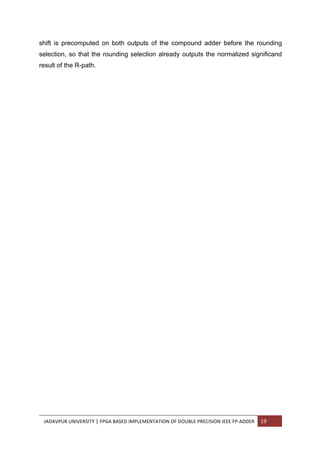
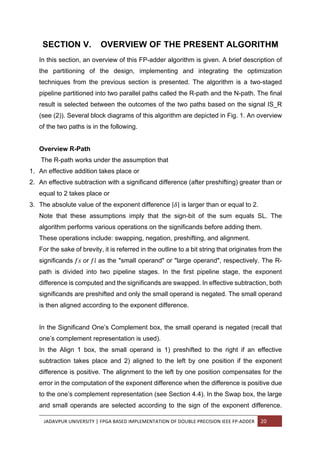
![JADAVPUR UNIVERSITY | FPGA BASED IMPLEMENTATION OF DOUBLE PRECISION IEEE FP-ADDER 21
Note that since swapping takes place only after complementation and Align 1, one
must consider complementing and aligning both significands; only one of these
significands is used as the small operand. In the Align2 box, the small operand is
aligned according to the computed exponent difference. The exponent difference box
computes the swap decision and the alignment shift amount. This box is further
partitioned into two paths for medium and large exponent differences. A detailed block
diagram for the implementation of the first cycle of the R-path is depicted in Fig. 2. The
input to the second pipeline stage consists of the large and small operands. The goal
is to compute their sum and round it while taking into account the error due to the one’s
complement representation for effective subtractions. The second pipeline stage is
very similar to the rounding algorithm presented in [8]. The large and small operands
are divided into a low part and a high part that are processed in parallel. The LSB of
the final result is computed based on the low part and the range of the sum. The rest
of the final result is computed based on the high part (i.e., either the sum or the
incremented sum of the high part). The outputs of the compound adder are
postnormalized before the rounding selection is performed. A detailed block diagram
for the implementation of the second cycle of the R-path is depicted in Fig. 2.
Overview N-Path
The N-path works under the assumption that an effective subtraction takes place, the
significand difference (after the swapping of the addends and preshifting) is less than
2, and the absolute value of the exponent difference is less than 2. The N-path has
the following properties:
The exponent difference must be in the set {-1,0,1}. Hence, the exponent difference
can be computed by subtracting the two LSBs of the exponent strings. The alignment
shift is by at most one position. This is implemented in the exponent difference
prediction box.
An effective subtraction takes place, hence, the small operand is always negated. The
one’s complement representation has been used for the negated subtrahend.
The significand difference (after swapping and preshifting) is in the range (-2,2) and
can be exactly represented using 52 bits to the right of the binary point. Hence, no
rounding is required
Based on the exponent difference prediction, the significands are swapped and
aligned by at most one bit position in the align and swap box. The leading zero](https://image.slidesharecdn.com/d660715b-140b-4198-b373-7f155384b941-160513193802/85/FPGA-BASED-IMPLEMENTATION-OF-DELAY-OPTIMISED-DOUBLE-PRECISION-IEEE-FLOATING-POINT-ADDER-22-320.jpg)



![JADAVPUR UNIVERSITY | FPGA BASED IMPLEMENTATION OF DOUBLE PRECISION IEEE FP-ADDER 25
SECTION VI. SPECIFICATION AND DETAILED
DESCRIPTION
In this section, specifically the computations in the R-path are discussed since they
cover most of the varieties of the input. A more detailed study is necessary for the
implementing prospects in the N-path. The two stages of the R-path are specified as
following.
Specification: R-Path First Cycle
The computation performed by the first pipeline stage in the R-path outputs the
significands and , represented by FLP[1 : 52] and FSOPA[1 : 116]. The
significands and are defined by,
(𝑓𝑙𝑝 , 𝑓𝑠𝑜𝑝𝑎 ) =
𝑓𝑙, 𝑓𝑠𝑎𝑛 𝑖𝑓 𝑆. 𝐸𝐹𝐹 = 0
(2 ∙ 𝑓𝑙 , 2 ∙ 𝑓𝑠𝑎𝑛 − 25116
) 𝑜𝑡 ℎ𝑒𝑟𝑤𝑖𝑠𝑒
The detailed view in Fig. 1 depicts how the computation of FLP[-1 : 52] and FSOPA[-
1 : 116] is performed. For each box in the high level view, a region surrounded by
dashed lines is depicted to assist the reader in matching the regions with blocks.
The exponent difference is computed for two ranges: The medium exponent difference
interval consists of [-63; 64], and the big exponent difference intervals consist of [-∞,-
64] and [65,∞]. The outputs of the exponent difference box are specified as follows:
Loosely speaking, the 𝑆𝐼𝐺𝑁_𝑀𝐸𝐷 and 𝑀𝐴𝐺_𝑀𝐸𝐷 are the sign-magnitude
representations of 𝛿, if 𝛿 is in the medium exponent difference interval. Formally,
−1 ]˜™š_›bœ
∙ 𝑀𝐴𝐺_𝑀𝐸𝐷 =
𝛿 − 1 𝑖𝑓 64 ≥ 𝛿 ≥ 1
𝛿 𝑖𝑓 0 ≥ 𝛿 ≥ −63
"don't care" otherwise
The reason for missing 𝛿 by 1 in the positive case is due to the one’s complement
subtraction of the exponents. This error term is compensated for in the Align1 box.
SIGN_BIG is the sign bit of exponent difference 𝛿. 𝐼𝑆_𝐵𝐼𝐺 is a flag defined by:
𝐼𝑆_𝐵𝐼𝐺 =
1 𝑖𝑓 𝛿 ≥ 65 𝑂𝑅 𝛿 ≤ −64
0 𝑜𝑡ℎ𝑒𝑟𝑤𝑖𝑠𝑒
In the big exponent difference intervals, the “required” alignment shift is at least 64
positions. Since all alignment shifts of 55 positions or more are equivalent (i.e., beyond
the sticky-bit position), the shift amount in this case may be limited. In the Align2
region, one of the following alignment shift occurs:](https://image.slidesharecdn.com/d660715b-140b-4198-b373-7f155384b941-160513193802/85/FPGA-BASED-IMPLEMENTATION-OF-DELAY-OPTIMISED-DOUBLE-PRECISION-IEEE-FLOATING-POINT-ADDER-26-320.jpg)
![JADAVPUR UNIVERSITY | FPGA BASED IMPLEMENTATION OF DOUBLE PRECISION IEEE FP-ADDER 26
a. a fixed alignment shift by 64 positions in case the exponent difference belongs to the
big exponent difference intervals (this alignment ignores the preshifting altogether) or
b. an alignment shift by 𝑚𝑎𝑔_𝑚𝑒𝑑 positions in case the exponent difference belongs to
the medium exponent difference interval.
In the One’s Complement box, the signals FAO, FBO, and S.EFF are computed. The
FAO and FBO signals are defined by
FAO[0 : 52],FBO[0 : 52] =
𝐹𝐴 0: 52 , 𝐹𝐵 0: 52 𝑖𝑓 𝑆. 𝐸𝐹𝐹 = 0
𝑛𝑜𝑡 𝐹𝐴 0: 52 , 𝑛𝑜𝑡 𝐹𝐵 0: 52 𝑜𝑡ℎ𝑒𝑟𝑤𝑖𝑠𝑒
The computations performed in the Preshift and Align 1 region are relevant only if the
exponent difference is in the medium exponent difference interval. The significands
are pre-shifted if an effective subtraction takes place. After the preshifting, an
alignment shift by one position takes place if sign med = 1. Table 1 summarizes the
specification of FSOP’[-1 : 53].
In the Swap region, the large operand is selected based on sign big. The small
operand is selected for the medium exponent difference (based on sign med) interval
and for the large exponent difference interval (based on sign big).
The Preshift 2 region deals with preshifting the minuend in case an effective
subtraction takes place.
Specification: R-path Second Cycle
Table 1 – Value of FSOP’ [-1:53] according to Fig. 1
SIGN_MED S.EFF Pre
shift
(Left)
Align
shift
(Right)
Accumulated
right shift
FSOP’[-1:53]
0 0 0 1 1 (00,FBO[0:52])
1 1 1 0 (1,FBO[0:52],1)
1 0 0 0 0 (0,FAO[0:52],0)
1 1 0 -1 (FAO[0:52],11)](https://image.slidesharecdn.com/d660715b-140b-4198-b373-7f155384b941-160513193802/85/FPGA-BASED-IMPLEMENTATION-OF-DELAY-OPTIMISED-DOUBLE-PRECISION-IEEE-FLOATING-POINT-ADDER-27-320.jpg)
![JADAVPUR UNIVERSITY | FPGA BASED IMPLEMENTATION OF DOUBLE PRECISION IEEE FP-ADDER 27
The input to the second cycle consists of: The sign bit SL, a representation of the
exponent el, the significand strings FLP[-1:52] and FSOPA[-1:116], and the rounding
mode.
Together with the sign bit SL, the rounding mode is reduced to one of the three
rounding modes: RZ, RNE or RI (see Section 4.3). The output consists of the sign bit
SL, the exponent string, and the normalized and rounded significand 𝑓_𝑓𝑎𝑟 ∈ [1,2)
represented by F_FAR[0 : 52]. If the significand sum (after pre-shifting) is greater than
or equal to 1, then the output of the second cycle of the R-path satisfies:
𝑟𝑛𝑑 𝑠𝑢𝑚 = 𝑟𝑛𝑑( −1 >;
∙ (𝑓𝑙𝑝 + 𝑓𝑠𝑜𝑝𝑎 + 𝑆. 𝐸𝐹𝐹 ∙ 25,,Ÿ
))
In effective subtraction, 25,,Ÿ
is added to correct the sum of the one’s complement
representations to the sum of two’s complement representations by the lazy increment
from the first clock cycle. Fig. 1 depicts the partitioning of the computations in the 2nd
cycle of the R-path into basic blocks and specifies the input- and output-signals of
each of these basic blocks.
Details: R-Path First Cycle
Fig. 2 depicts a detailed block diagram of the first cycle of the R-path. The
nonstraightforward regions are described below.
The Exponent Difference region is implemented by cascading a 7-bit adder with a 5-
bit adder. The 7-bit adder computes the lazy one’s complement exponent difference if
the exponent difference is in the medium interval. This difference is converted to a
sign and magnitude representation denoted by 𝑠𝑖𝑔𝑛_𝑚𝑒𝑑 and 𝑚𝑎𝑔_𝑚𝑒𝑑 . The
cascading of the adders enables us to evaluate the exponent difference (for the
medium interval) in parallel with determining whether the exponent difference is in the
big range. The SIGN_BIG signal is simply the MSB of the lazy one’s complement
exponent difference. The IS_BIG signal is computed by OR-ing the bits in positions [6
: 10] of the magnitude of the lazy one’s complement exponent difference. This explains
why the medium interval is not symmetric around zero.
The Align 1 region depicted in Fig. 2 is an optimization of the Preshift and Align1 region
in Fig. 1. The reader can verify that the implementation of the Align 1 region satisfies
the specification of FSOP’[-1 : 53] that is summarized in Table 1.](https://image.slidesharecdn.com/d660715b-140b-4198-b373-7f155384b941-160513193802/85/FPGA-BASED-IMPLEMENTATION-OF-DELAY-OPTIMISED-DOUBLE-PRECISION-IEEE-FLOATING-POINT-ADDER-28-320.jpg)
![JADAVPUR UNIVERSITY | FPGA BASED IMPLEMENTATION OF DOUBLE PRECISION IEEE FP-ADDER 28
The following condition is computed during the computation of the exponent
difference 𝐼𝑆_𝑅1 ⟺ ( 𝑒𝑎 − 𝑒𝑏 ) ≥ 2
⟺ 𝑂𝑅𝑡𝑟𝑒𝑒(𝐼𝑆_𝐵𝐼𝐺 , 𝑀𝐴𝐺_𝑀𝐸𝐷[5: 0], 𝐴𝑁𝐷(𝑀𝐴𝐺_𝑀𝐸𝐷(0), 𝑁𝑂𝑇(𝑆𝐼𝐺𝑁_𝐵𝐼𝐺))),
which will be used later for the selection of the valid path. Note that, the exponent
difference is computed using one’s complement representation. This implies that the
magnitude is off by one when the exponent difference is positive. In particular, the
case of the exponent difference equal to 2 yields a magnitude of 1 and a sign bit of 0.
This is why the expression AND(MAG_MED[0],NOT(SIGN BIG)) appears in the OR-
tree used to compute the IS_R signal.
Details: R-Path Second Cycle
Fig. 2 depicts a detailed block diagram of the second cycle of the R-path. The details
of the implementation are described below. Our implementation of the R-path in the
second cycle consists of two parallel paths called the upper part and the lower part.
The upper part deals with positions [-1:52] of the significands and the lower part deals
with positions [53:116] of the significands. The processing of the lower part has to take
into account two additional values: the rounding injection, which depends only on the
reduced rounding mode, and the missing ULP (2_116) in effective subtraction due to
the one’s complement representation. The processing of FSOPA[53:116], INJ[53:116]
and S.EFF ∙ 25,,Ÿ
is based on:
𝑇𝐴𝐼𝐿[52: 116] =
𝐹𝑆𝑂𝑃𝐴[53: 116] + 𝐼𝑁𝐽[53: 116] 𝑖𝑓 𝑆. 𝐸𝐹𝐹 = 0
𝐹𝑆𝑂𝑃𝐴[53: 116] + 𝐼𝑁𝐽[53: 116] + 25,,Ÿ
𝑖𝑓 𝑆. 𝐸𝐹𝐹 = 1
The bits 𝐶[52], 𝑅’, 𝑆’ are defined by 𝐶[52] = 𝑇𝐴𝐼𝐿[52] , R’=TAIL[53],
S’=OR(TAIL[54:116]). They are computed by using a 2-bit injection string that has a
different value for effective addition and subtraction.
Effective addition- Let 𝑆:…… denote the sticky bit that corresponds to FSOPA[54:116],
then 𝑆:……= OR(FSOPA[54], . . . ,FSOPA[116]). The injection can be restricted to two
bits INJ[53 : 54] and we simply perform a 2-bit addition to obtain the three bits C[52],R’,
S’:
(𝐶 52 , 𝑅′
, 𝑆′) = 𝐼𝑁𝐽[53: 54] + (𝐹𝑆𝑂𝑃𝐴 53 , 𝑆:……) .](https://image.slidesharecdn.com/d660715b-140b-4198-b373-7f155384b941-160513193802/85/FPGA-BASED-IMPLEMENTATION-OF-DELAY-OPTIMISED-DOUBLE-PRECISION-IEEE-FLOATING-POINT-ADDER-29-320.jpg)
![JADAVPUR UNIVERSITY | FPGA BASED IMPLEMENTATION OF DOUBLE PRECISION IEEE FP-ADDER 29
Effective subtraction- In this case, we still have to add to FSOPA the missing 25,,Ÿ
that we neglected to add during the first cycle. Let 𝑆>kS denote the sticky bit that
corresponds to bit positions [54:116] in the binary representation of
𝐹𝑆𝑂𝑃𝐴[54: 116] + 25,,Ÿ
, then 𝑆>kS = 𝑂𝑅(𝑁𝑂𝑇(𝐹𝑆𝑂𝑃𝐴[54: 116])),
The addition of 25,,Ÿ
can create a carry to position [53], which we denote by C[53].
The value of C[53] is one if FSOPA[54:116] is all ones, in which case the addition of
25,,Ÿ
creates a carry that ripples to position [53]. Therefore, C[53]=NOT(𝑆>kS). Again,
the injection can be restricted to two bits INJ[53:54], and we compute C[52],R’, S’ by
(𝐶 52 , 𝑅′
, 𝑆′) = 𝐼𝑁𝐽[53: 54] + (𝐹𝑆𝑂𝑃𝐴 53 , 𝑆:……) + 2𝐶[53]
The result of this addition cannot be greater than 7 ∙ 25z‘
, because C[53]= NOT(𝑠>kS).
A fast implementation of the computation of C[52], R’, S’ proceeds as follows. Let S
=𝑆:…… in effective addition, and S= 𝑆>kS in effective subtraction. Based on S.EFF,
FSOPA[53] and INJ[53:54], the signals C[52], R’, S’ are computed in two paths: one
assuming that S = 1 and the other assuming that S = 0.
Fig. 2 depicts a naive method of computing the sticky bit S to keep the presentation
structured rather than obscure it with optimizations. A conditional inversion of the bits
of FSOPA[54 : 116] is performed by XOR-ing the bits with S.EFF. The possibly
inverted bits are then input to an OR-tree. This suggestion is somewhat slow and
costly. A better method would be to compute the OR and AND of (most of) the bits of
FS[54 : 116] during the alignment shift in the first cycle. The advantages of advancing
(most of) the sticky bit computation to the first cycle is twofold:
1) There is ample time during the alignment shift whereas the sticky bit should be ready
after at most 5 logic levels in the second cycle; and
2) This saves the need to latch all 63 bits (corresponding to FS[54 : 116]) between the
two pipeline stages. The upper part computes the correctly rounded sum (including
post-normalization) and uses for the computation of the strings FLP[-1:52],FSOPA[-
1:52], and (C[52],R’, S’).
The rest of the algorithm is identical to the rounding presented, analyzed, and proven
in [8] for FP multiplication.](https://image.slidesharecdn.com/d660715b-140b-4198-b373-7f155384b941-160513193802/85/FPGA-BASED-IMPLEMENTATION-OF-DELAY-OPTIMISED-DOUBLE-PRECISION-IEEE-FLOATING-POINT-ADDER-30-320.jpg)
![JADAVPUR UNIVERSITY | FPGA BASED IMPLEMENTATION OF DOUBLE PRECISION IEEE FP-ADDER 30
SECTION VII. DELAY ANALYSIS REPORTING
In this section, the delay of this FP-adder algorithm has been reported. The original
analysis was made by using the Logical Effort Model [33]. In the analysis of gate
delays, this delay model allows a rigorous treatment of the contributions of fanouts
and gate sizing independent of the used technology, process, voltage, or feature size.
Based on this delay model, a proposal of the delay-optimal implementation of this FP
addition algorithm was made by the authors, by considering optimized gate sizing and
driver insertion. For comparisons the delay estimations are scaled from this model to
units of FO4 inverter delays (inverter delay with a fanout of four). The use of this unit
has been a popular choice in literature on circuit design whenever delays are to be
determined in technology-independent terms. It has been demonstrated for several
examples that delay estimations in FO4 delay units are rather insensitive to choices
of technological parameters [12]. The description of, how the delay analysis, provided
by the authors, differ from the traditional one, has been described in [28], [29]. In the
more recent analysis, each gate is assigned an independent size and delay. This
allows for precise modeling of fanout contributions and full custom gate size
optimizations for minimum delay. The previously estimated the total delay of this
algorithm was 24 logic levels between latches, which could be evenly partitioned into
two stages with 12 logic levels each. One logic level (XOR delay with a fanout of 1)
has a delay of 1.6 FO4 inverter delay units in the current framework (this is because
d(XOR1) = 8 logical effort delays and d(FO4) = 5 logical effort delays), so that the
previous analysis estimated the delay of this algorithm to be 38:4 FO4 delays. This is
approximately 19 FO4 delays for each of two pipeline stages between latches.](https://image.slidesharecdn.com/d660715b-140b-4198-b373-7f155384b941-160513193802/85/FPGA-BASED-IMPLEMENTATION-OF-DELAY-OPTIMISED-DOUBLE-PRECISION-IEEE-FLOATING-POINT-ADDER-31-320.jpg)




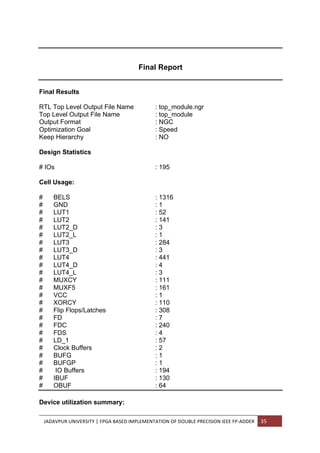


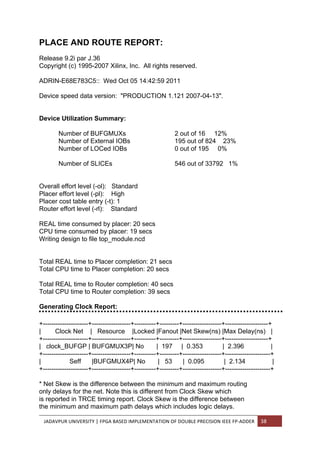

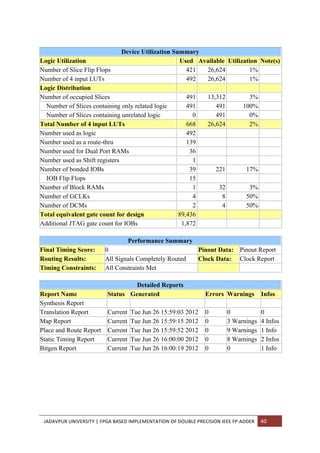



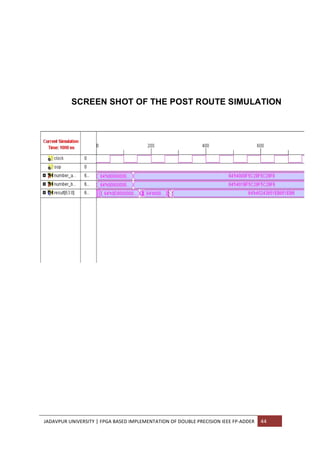

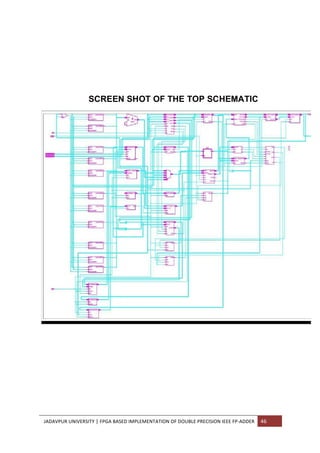


![JADAVPUR UNIVERSITY | FPGA BASED IMPLEMENTATION OF DOUBLE PRECISION IEEE FP-ADDER 49
BIBLIOGRAPHY
[1] S. Bar-Or, G. Even, and Y. Levin, “Generation of Representative Input Vectors for
Parametric Designs: from Low Precision to High Precision,” Integration, the VLSI J.,
vol. 36, issues 1-2, pp. 69-82, Sept. 2003.
[2] A. Beaumont-Smith, N. Burgess, S. Lefrere, and C. Lim, “Reduced Latency IEEE
Floating-Point Standard Adder Architectures,” Proc.14th IEEE Symp. Computer
Arithmetic, pp. 35-43, 1999.
[3] R. Brent and H. Kung, “A Regular Layout for Parallel Adders,” IEEE Trans. On
computers, vol. 31, no. 3, pp. 260-264, Mar. 1982.
[4] J. Bruguera and T. Lang, “Using the Reverse-Carry Approach for Double-Datapath
Floating-Point Addition,” Proc. 15th IEEE Int’l Symp. Computer Arithmetic (Arith15),
pp. 203-210, June 2001.
[5] M. Daumas and D. Matula, “Recoders for Partial Compression and Rounding,”
Technical Report RR97-01, Ecole Normale Superieur de Lyon, LIP 1996.
[6] L. Eisen, T. Elliott, R. Golla, and C. Olson, “Method and System for Performing a
High Speed Floating Point Add Operation.” IBM Corporation, US patent 5790445,
1998.
[7] G. Even, S. Mu¨ ller, and P. Seidel, “Dual Precision IEEE Floating- Point Multiplier,”
INTEGRATION The VLSI J., vol. 29, no. 2, pp. 167-180, Sept. 2000.
[8] G. Even and P.-M. Seidel, “A Comparison of Three Rounding Algorithms for IEEE
Floating-Point Multiplication,” IEEE Trans Computers, vol. 49, no. 7, pp. 638-650, July
2000.
[9] P. Farmwald, “On the Design of High Performance Digital Arithmetic Units,” PhD
thesis, Stanford Univ., Aug. 1981
[10] P. Farmwald, “Bifurcated Method and Apparatus for Floating-Point Addition with
Decreased Latency Time,” US patent 4639887,1987.
[11] V. Gorshtein, A. Grushin, and S. Shevtsov, “Floating Point Addition Methods and
Apparatus.” Sun Microsystems, US patent 5808926, 1998.
[12]M.Horowitz,“VLSI Scaling for Architects,” http://velox.stanford.
du/papers/VLSIScaling.pdf, 2000.
[13] “IEEE Standard for Binary Floating Point Arithmetic, ”ANSI/ IEEE754-1985, 1985.
[14] T. Ishikawa, “Method for Adding/Subtracting Floating-Point Representation Data
and Apparatus for the Same,” Toshiba, K.K., US patent 5063530, 1991.](https://image.slidesharecdn.com/d660715b-140b-4198-b373-7f155384b941-160513193802/85/FPGA-BASED-IMPLEMENTATION-OF-DELAY-OPTIMISED-DOUBLE-PRECISION-IEEE-FLOATING-POINT-ADDER-50-320.jpg)
![JADAVPUR UNIVERSITY | FPGA BASED IMPLEMENTATION OF DOUBLE PRECISION IEEE FP-ADDER 50
[15] T. Kawaguchi, “Floating Point Addition and Subtraction Arithmetic Circuit
Performing Preprocessing of Addition or Subtraction Operation Rapidly,” NEC, US
patent 5931896, 1999.
[16] Y. Levin, “Supporting Demoralized Numbers in an IEEE Compliant Floating Point
Adder Optimized for Speed,” http:// hyde.eng.tau.ac.il/Projects/FPADD/index.html,
2001.
[17] A. Naini, A. Dhablania, W. James, and D. Das Sarma, “1-GHz HAL SPARC64
Dual Floating Point Unit with RAS Features,” Proc. 15th IEEE Int’l Symp. Computer
Arithmetic (Arith15), pp. 173- 183, June 2001.
[18] T. Nakayama, “Hardware Arrangement for Floating-Point Addition and
Subtraction,” NEC, US patent 5197023, 1993.
[19] K. Ng, “Floating-Point ALU with Parallel Paths,” US patent 5136536, Weitek Corp.,
1992.
[20] A. Nielsen, D. Matula, C.-N. Lyu, and G. Even, “IEEE Compliant Floating-Point
Adder that Conforms with the Pipelined Packet- Forwarding Paradigm,” IEEE Trans.
Computers, vol. 49, no. 1,pp. 33-47, Jan. 2000.
[21] S. Oberman, “Floating-Point Arithmetic Unit Including an Efficient Close Data
Path,” AMD, US patent 6094668, 2000.
[22] S. Oberman, H. Al-Twaijry, and M. Flynn, “The SNAP Project: Design of Floating
Point Arithmetic Units,” Proc. 13th IEEE Symp.Computer Arithmetic, pp. 156-165,
1997.
[23] W.-C. Park, T.-D. Han, S.-D. Kim, and S.-B. Yang, “Floating Point
Adder/Subtractor Performing IEEE Rounding and Addition/Subtraction in Parallel,”
IEICE Trans. Information and Systems, vol. 4, pp. 297-305, 1996.
[24] N. Quach and M. Flynn, “Design and Implementation of the SNAP Floating-Point
Adder,” Technical Report CSL-TR-91-501,Stanford Univ., Dec. 1991.
[25] N. Quach, N. Takagi, and M. Flynn, “On fast IEEE Rounding,” Technical Report
CSL-TR-91-459, Stanford Univ., Jan. 1991.
[26] M. Schmookler and K. Nowka, “Leading Zero Anticipation and Detection—A
Comparison of Methods, Proc. 15th IEEE Symp.Computer Arithmetic, pp. 7-12, 2001.
[27] P.-M. Seidel, “On The Design of IEEE Compliant Floating-Point Units and Their
Quantitative Analysis,” PhD thesis, Univ. of Saarland, Germany, Dec. 1999.
[28] P.-M. Seidel and G. Even, “How Many Logic Levels Does Floating-Point Addition
Require?” Proc. 1998 Int’l Conf. Computer Design (ICCD ’98): VLSI, in Computers &
Processors, pp. 142-149, Oct. 1998.](https://image.slidesharecdn.com/d660715b-140b-4198-b373-7f155384b941-160513193802/85/FPGA-BASED-IMPLEMENTATION-OF-DELAY-OPTIMISED-DOUBLE-PRECISION-IEEE-FLOATING-POINT-ADDER-51-320.jpg)
![JADAVPUR UNIVERSITY | FPGA BASED IMPLEMENTATION OF DOUBLE PRECISION IEEE FP-ADDER 51
[29] P.-M. Seidel and G. Even, “On the Design of Fast IEEE Floating- Point Adders,”
Proc. 15th IEEE Int’l Symp. Computer Arithmetic (Arith15), pp. 184-194, June 2001.
[30] P.-M. Seidel and G. Even, “Delay-Optimized Implementation of IEEE Floating-
Point Addition,” http://www.engr.smu.edu/ seidel/research/fpadd/, 2002.
[31] H. Sit, D. Galbi, and A. Chan, “Circuit for Adding/Subtracting Two Floating-Point
Operands,” Intel, US patent 5027308, 1991.
[32] D. Stiles, “Method and Apparatus for Performing Floating-Point Addition,” AMD,
US patent 5764556, 1998.
[33] I. Sutherland, B. Sproull, and D. Harris, Logical Effort: Designing Fast CMOS
Circuits. Morgan Kaufmann 1999.
[34] A. Tyagi, “A Reduced-Area Scheme for Carry-Select Adders,” IEEE Trans.
Computers, vol. 42, no. 10, Oct. 1993.
[35] H. Yamada, F. Murabayashi, T. Yamauchi, T. Hotta, H. Sawamoto, T. Nishiyama,
Y. Kiyoshige, and N. Ido, “Floating-Point Addition/ Subtraction Processing Apparatus
and Method Thereof,” Hitachi, US patent 5684729, 1997.
[36] Stefan Sjoholm, Lennart Lindh “VHDL for designers” Prentice Hall Europe, ISBN
0-13-473414-9.
[37] Kavin Skahill “VHDL for PROGRAMMABLE LOGIC”
[38] ACTEL “HDL CODING style guide”.](https://image.slidesharecdn.com/d660715b-140b-4198-b373-7f155384b941-160513193802/85/FPGA-BASED-IMPLEMENTATION-OF-DELAY-OPTIMISED-DOUBLE-PRECISION-IEEE-FLOATING-POINT-ADDER-52-320.jpg)